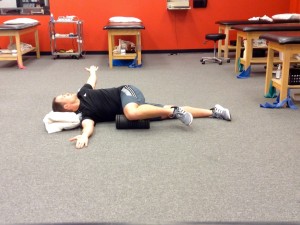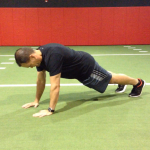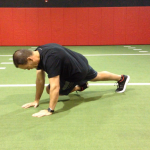Brian Schiff’s Blog
Injury Prevention, Sports Rehab & Performance Training Expert
This post is dedicated to improving mobility in two areas I commonly find restrictions in among my clients – the ankle and thoracic spine. Specifically, I often find limitations in dorsiflexion and thoracic spine rotation that create undue stress on other parts of the kinetic chain.

Standing wall touch
Recently, I wrote an article for the WeckMethod site on how to assess and improve ankle mobility. As a clinician and coach, I see this issue in many runners and athletes I work with. At times, it is joint restriction, while in other cases it is soft tissue limitations that impact mobility.
There are several potential reasons why one might possess less than optimal movement in the ankle. The most common causes include: joint stiffness following injury and/or immobilization, soft tissue tightness in the gastroc/soleus complex, scar tissue from a prior injury, anterior ankle impingement, chronic ankle instability and adaptive shortening of the Achilles tendon. Want to read more?
Click here to read my article on the WeckMethod site
Decreased mobility in the thoracic spine often creates dysfunction and stress on other parts of the kinetic chain, namely the shoulder and lumbar spine. In many cases, clients will demonstrate asymmetry based on their sport, activity level and injury history. In light of this, I often prescribe a simple, yet effective corrective exercise they can do at home to restore motion. The exercise below is taken from my ‘Functionally Fit’ column I recently did for PFP Magazine.

Side lying t-spine roll
In the full online column, I reveal two ways to do this and the applications for it. This exercise also offers a way to assess your own range of motion, while teaching you a straightforward corrective exercise to improve mobility.

Halo Trainer
I recently received a Halo Trainer from Bryce Taylor, its inventor and program director. I am fortunate enough to test and sample many new products related to fitness and rehab. Many of them are one dimensional, full of fluff or new takes on an old product. This product really delivers for those in the rehab and fitness worlds.
Disclaimer: I am not being compensated for this product review or paid to endorse this product. I simply love what it has to offer. The Halo Trainer offers countless training possibilities for so many people despite their backgrounds and abilities.
In fact, here is an excerpt from the Halo Trainer website:
Halo Training currently consists of 4 levels of difficulty for functional bodyweight training. We all know that people have various levels of strength, flexibility, coordination, etc. so we at Halo Rehab & Fitness believe that individuals should not be performing the same exercises. Although it is always to goal to increase the challenge, it is not always appropriate. Sometimes an exercise can be advanced and other times an exercise needs to be made a little easier to meet the specific level of the individual.
For this reason, the Halo training development team has created four distinct levels of difficulty based on scientific principles. Our team has created levels of difficulty for over 300 exercises so that you can create a specific progressive individualized program to maximize bodyweight training. Just pick a starting level and progress to the next level when you are able to complete the challenges of your current level.

So, I just returned from the Combined Sections Meeting for the APTA that was held in Indianapolis. There was lots of great networking and presentations to be sure. I attended sessions on ACL rehab/prevention, femoroacetabular impingement, elbow injuries in throwers, running gait analysis, and shoulder plyometric training with the legendary George Davies. I thought I would give you my top 10 list of helpful nuggets I picked up over the weekend in no particular order of importance.
1. Performing upper body plyometrics has no effect on untrained subjects so don’t waste time putting it into the rehab program, where as it does benefit trained overhead athletes. The one caveat is it also increases passive horizontal external rotation so keep this in mind when working with athletes who have shoulder instability.
2. A new study coming out in 2015 in AJSM revealed no major differences in throwing kinematics between those following UCL reconstruction (Tommy John) and age-matched controls. This is good news for those worried about pitching mechanics after the procedure.
3. According to Dr. Reiman at Duke, the orthopedic hip exam does a better job of telling us they do not have a labral tear than it does telling us they do have an intra-articular problem. The tests have poor specificity. In fact, he goes on to say that the “special tests are not that special.” That brought a chuckle from the crowd including me. Bottom line – we are not really able to conclusively say “yes you have a labral tear based on my exam today.
4. Reiman also feels we must consider look for mechanical symptoms during the lowering portion of the Thomas test, while considering the fact that fat pad impingement may cause anterior hip pain as opposed to joint pain. Again, things are not always as they appear in the “FAI” crowd so we need to take a great history, look at the classic tests and also see how squatting and loading affects the hip.
5. More experienced pitchers do not drop the glove side arm, but instead tend to move their body toward the glove to conserve angular momentum and overcome small moments of inertia. Less experienced pitchers rotate their trunk sooner in pitching cycles whereas pitchers who threw at higher levels rotated later and produced less torque at the shoulder. Consequently, many players with higher elbow valgus torque and distraction force at the shoulder rotate too early.
Increasing shoulder, torso and hip strength and stability is a common training goal for athletes involved in sport. Facilitating hip disassociation and kinetic chain linking with exercise is always a plus. I like to use a diagonal mountain climber with hip extension to accomplish these objectives. More specifically, I utilize this exercise with my overhead athletes and anyone involved in cutting, pivoting and rotational sports.
Begin in a tall plank position. The hands should be beneath the shoulders with the feet on the floor and shoulder width apart. Slowly bring the left knee/hip under the body and toward the right elbow. Pause at the end point prior to losing form or control.
Next, return the left leg toward the start position and up into full hip extension in one continuous movement. Pause at the top end of available hip extension and repeat the cycle for 10 repetitions or time on the same leg. Alternate legs and perform 2-3 sets on each side.
Sufficient upper body strength and core/hip stability in a 3 point position is necessary to perform the exercise correctly. At no time should the foot of the moving leg touch the floor or be used to balance the body. As far as a pace, I feel using a 1/1/1/1 cadence works best.
This exercise is an excellent way to promote shoulder, core and hip stability while facilitating hip disassociation as well. Driving the hip back up into extension will activate the gluteals and simultaneously force the stable (fixed) hip to stabilize the pelvis and counterbalance the movement pattern. In addition, the client will have to effectively activate the hip and abdominal musculature throughout to avoid unwanted pelvic tilt/rotation during the movement.
Click here to view the full video of this exercise I did for my ‘Functionally Fit’ column for PFP Magazine.
All effective prehab and rehab programs for recreational and competitive athletes should include single leg stability exercises. I like to use sliding exercises as one way to improve neuromuscular control of the core, hip and knee. Frontal plane collapse is a common issue with respect to knee dysfunction. Using sliders/gliding discs as well as theraband is an excellent way to improve strength and kinetic chain control. Below is an exercise i recently featured for Personal Fitness Professional:
This exercise is effective in injury prevention and rehab programs for those with ankle instability, anterior knee pain, hip weakness, poor landing mechanics and higher ACL risk if playing pivoting and cutting sports. It will improve core stability, hip and knee strength/stability, dynamic balance, groin flexibility and trunk control.
The band serves to enhance activation of the hip external rotators and further challenge stability of the hip and knee. The band should not pull too forcefully, but just enough to cue the desired muscle activation pattern. A slower cadence on the eccentric portion of the exercise is preferable to maximize stability and strength gains. Do not force through any painful ranges of motion, and remember that form and alignment are paramount so limit the reaching based on the client’s ability to maintain adequate control.




